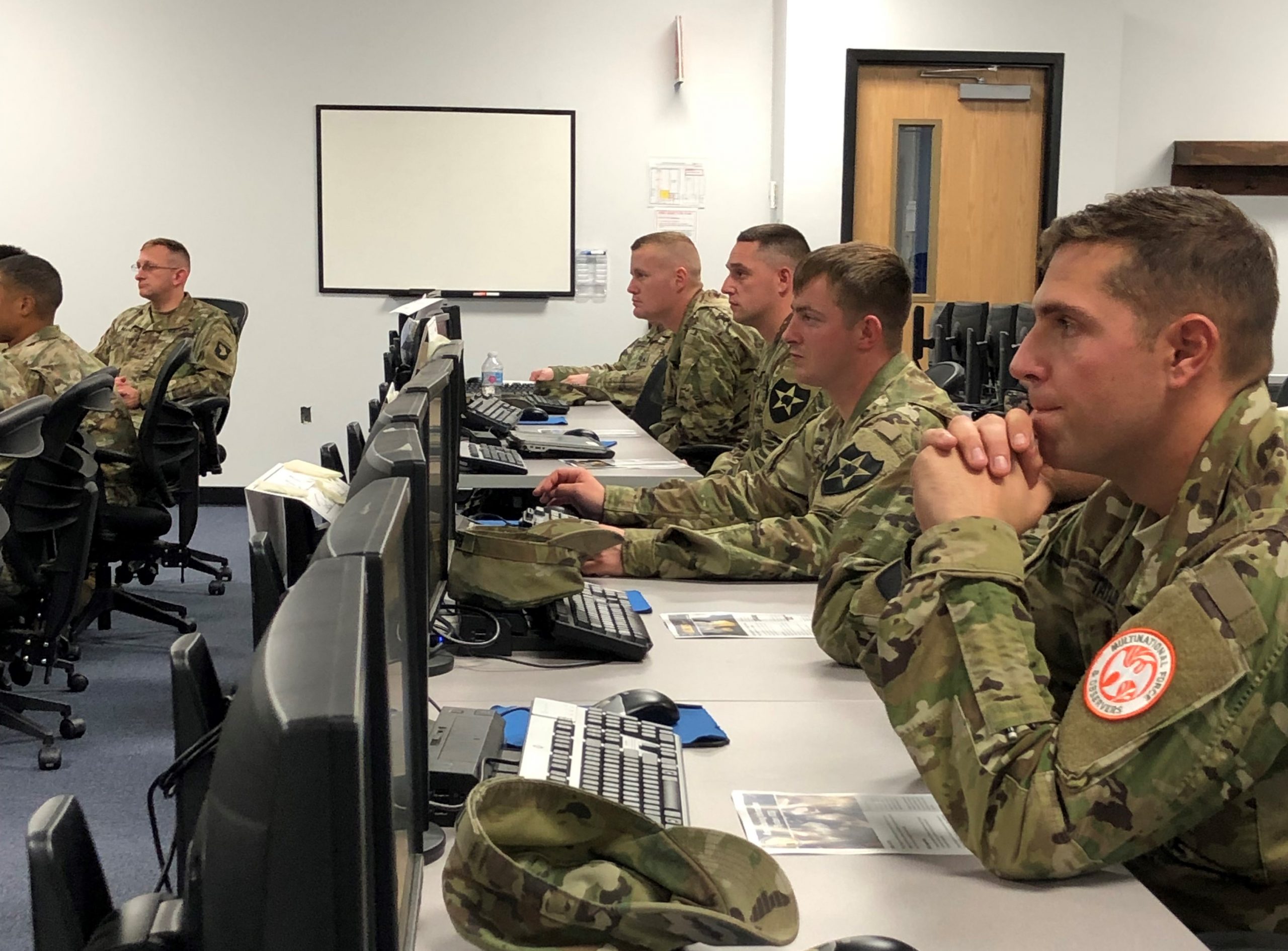
The Army Training Information System is using human-centered design to provide value to Soldiers.
by Lt. Col. Jim A. Lee
The acquisition community is in the midst of a seismic shift. Large-scale acquisitions typically follow a set of rigid rules by which people must play; the pitfalls of this approach, however, are numerous. One obstacle is the tendency to place more value on the acquisition process itself than on providing innovation and value for Soldiers.
This line of thinking is beginning to change. Although incremental in nature, a culture shift is beginning to affect the ways in which the acquisition community thinks, works and plans. In fact, this nascent shift is formalized in places like the Defense Innovation Board, which strives to recommend industry best practices to DOD challenges. To that end, there is increasing recognition that strict adherence to a project plan can stifle innovation and deter progress, and that Soldiers—not binders containing regulations and guidelines—should take priority. To maximize value to Soldiers, some acquisition teams are beginning to embrace flexible product development and its inherent unpredictability. Adopting an agile approach integrates iterative project development, which is a radical break from traditional acquisition behavior.
The Program Executive Office for Enterprise Information Systems’ (PEO EIS) Army Training Information System (ATIS) team is embracing this change of culture and process to provide valuable training to Soldiers.
Prior to ATIS, there has not been a centralized system providing Army commanders, leaders, Soldiers and civilians with a common operating picture of the training environment across the three domains: operational, institutional and self-development. Currently, training managers and users have to log in to disparate systems hosted at various sites to manage and manually coordinate training events. As a result, they have to create workarounds for their unique circumstances and are unable to use real-time data in the field.
The vision of ATIS is to deliver a customer-focused, worldwide, adaptive Army training enterprise capability to enable training readiness for the total force, anytime, anywhere.
ATIS is fielding a one-stop training solution for military and civilian personnel that will roll out with limited deployment in fiscal year 2023 and full deployment in fiscal year 2024. This system will provide the roughly 2 million Soldiers (active, Reserve, National Guard) and DA civilians with timely and cost-effective training, which will support a relevant and ready Army. ATIS will retire 28 cumbersome, duplicative legacy training systems and will streamline data interfaces among 56 others. This single-entry, integrated system will subsume the Digital Training Management System (DTMS) along with the Army Learning Management System (ALMS). The current environment requires the Soldier to enter duplicate data in multiple systems, often driving him or her to find workarounds just to accomplish day-to-day tasks. The drive to retire 28 systems and deliver a new, user-friendly, single sign-on training experience for the Soldier required a novel approach.

COMMUNICATION IS KEY: Soldiers discuss how ATIS will help improve the way they access training. (Photos courtesy of ATIS)
ESTABLISHING NEW ACQUISITION NORMS
When the U.S. Army Training and Doctrine Command (TRADOC) generated the requirements for ATIS, the program office knew that creating a single-entry training system would be a challenge. Overall, there are over 80 systems that will be subsumed or will feed data to ATIS; some of these systems are authoritative, but many are not, and all need to come together seamlessly. TRADOC also required that ATIS be a marked improvement from what Soldiers are currently using to execute training, and that it be user-friendly.
To address these challenges and meet these requirements, ATIS leveraged the other-transaction authority acquisition strategy to deliver training capabilities to Soldiers quickly, and to engage the user community early on and continuously during the system’s development.
ATIS chose the Scaled Agile Framework (SAFe) methodology to support the development of the system. SAFe—in contrast to more conventional project management approaches—breaks up work into smaller, digestible system deployments. Developers deliver potentially releasable increments of products on a schedule, gather feedback from Soldiers, and adjust or enhance the products. This iterative process amplifies Soldiers’ voices throughout the development process. Their feedback enables developers to course-correct and provides guideposts for future product releases.
According to Col. Jonathan Hughes, director of the TRADOC Proponent Office – Army Training Information Systems, “Using an agile process during the development of ATIS affords the Army multiple touch points to shape the final product. Commanders and Soldiers who will use ATIS in the future are able to provide input as the system evolves. Constant feedback to the development team will help ensure ATIS is intuitive, easy to use and effective for planning, executing and assessing Army training and education.”
PUTTING THE SOLDIER AND CIVILIAN FIRST
Two core risks that ATIS has sought to mitigate are usability and user acceptance. Human-centered design, organizational change management and user training and education teams joined the program early during the agile development process to address these concerns, ensuring that Soldiers would help build ATIS. The purpose of human-centered design is to ensure that Soldiers’ feedback is incorporated during each step of the development process. A multidisciplinary team of stakeholders—the Human Factors Working Group—has met regularly to obtain feedback from the user community. This group, comprising both Soldiers and civilians at various installations, aims to elevate the user voice and bring it back to the development team.
According to Col. Donald L. Burton, project manager for PEO EIS’s Defense Integrated Business Systems portfolio, “Our Soldiers need to know that the Army is putting their wishes at the forefront in the development of ATIS. The Human Factors Working Group is helping do just that.”
Organizational change management has helped facilitate the feedback and deliver clear and concise messaging about the impact that ATIS will have on Soldiers. By being involved in the process, Soldiers have helped create a solution that is understandable and provides quick transitions, eliminating inefficient and prolonged learning period during transition and implementation. Engaging the user community early and often in the development process has helped ensure that maximum value is delivered to Soldiers and DA civilians.

CONTINUOUS FEEDBACK LOOP: The Human-Centered Design team uses real-time feedback from the community to capture requirements that are important to them. User feedback obtained via surveys and future focus groups is foundational to creating ATIS.
CONCLUSION
A nascent culture shift in the acquisition of capability is pulling our community toward a more innovative, agile way of working. Incremental changes in our thinking—promoted from those within leadership—will deliver a more responsive product that better serves our Soldiers. An agile approach will create a better product but also will incorporate the concerns of the user community throughout the development process. Soldiers’ voices will be amplified early, which will catalyze continuous improvement. This change will not be immediate, and adopting it will be difficult. The potential benefits of embracing this paradigm shift, however, will deliver lasting impact for our Soldiers—by retiring 28 legacy systems and improving data exchange among 56 others, the Soldier will experience a training environment that is easier to use and more responsive to his or her professional needs. This experience will save Soldiers’ time that can be better spent on training readiness.
For updates and more information on ATIS, please find us at: https://www.pdmatis.army.mil/Index.html.
COL. JIM A. LEE is the product manager for the Army Training Information System (ATIS) program in Newport News, Virginia. Lee holds an associate of arts degree from Marion Military Institute and a Bachelor of Business degree and Master of International Business degree from Florida International University. His awards and decorations include the Defense Meritorious Service Medal, Meritorious Service Medal with four Oak Leaf Clusters, Joint Service Achievement Medal, Army Achievement Medal with two Oak Leaf Clusters, Joint Meritorious Unit Award, Iraqi Campaign Medal, Global War on Terrorism Expeditionary Medal, Korean Defense Service Medal, Humanitarian Assistance Medal, Combat Action Badge, Recruiting Badge, and Order of St. Barbara.
Read the full article in the Spring 2021 issue of Army AL&T magazine.
Subscribe to Army AL&T – the premier source of Army acquisition news and information.
![]()


